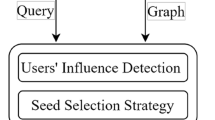Abstract
With the wide popularization of the 5G network and the technology of IoT, a variety of mobile terminals has become a necessity for people’s daily life. In the popular environment of the mobile terminals, the high-frequency radio wave mainly promoted by 5G communication has obvious deficiencies in network coverage, which makes the opportunistic network particularly important at present. At present, there are many routing algorithms for opportunistic networks, but most of them only consider the distance between nodes, the occupation of resources, and the success probability of transmission. It leads to the underutilization of a large amount of valuable information brought by each node itself and makes the message transmission and users’ usage habits separate, which causes lots of meaningless message transmission and is prone to information leakage. According to this, this paper establishes an information transmission mode in opportunistic social networks based on user influence (ITMUI), which uses the analysis of the influence of nodes in the network community to filter and purposefully transmit information by taking the influence factor as a part of the path weight, so as to further improve the transmission efficiency of the opportunistic network. Moreover, after considering the information of the node itself, the communication of the network can change with the change of the environment and the node. The research of this strategy is mainly divided into two parts. The first part is the analysis of user influence, and the second part is the reconstruction of the IoT community structure combined with the analysis results. Simulation results show that ITMUI has 6% less transmission delay than other models and 12% higher delivery ratio than the average model, which means that compared with other algorithms, this algorithm costs less and can significantly improve the data transmission efficiency.










Similar content being viewed by others
References
Gou F, Wu J (2022) Message transmission strategy based on recurrent neural network and attention mechanism in IoT system. J Circ Syst Comput 31(7)
Wu J, Chen Z, Zhao M (2020) An efficient data packet iteration and transmission algorithm in opportunistic social networks. J Ambient Intell Humaniz Comput 11:3141–3153. https://doi.org/10.1007/s12652-019-01480-2
Wu J, Gou F, Tian X (2022) “Disease control and prevention in rare plants based on the dominant population selection method in opportunistic social networks. Comput Intell Neurosci. 2022(1489988):16. https://doi.org/10.1155/2022/1489988
Wu X, Chang L, Luo J et al (2021) Efficient edge cache collaboration transmission strategy of opportunistic social network in trusted community. IEEE Access 9:51772–51783. https://doi.org/10.1109/ACCESS.2021.3069992
Wu J, Chen Z, Zhao M (2020) Community recombination and duplication node traverse algorithm in opportunistic social networks. Peer-to-Peer Netw Appl 13:940–947.https://doi.org/10.1007/s12083-019-00833-0
Wu J, Zou W, Long H (2021) Effective path prediction and data transmission in opportunistic social networks. IET Commun. https://doi.org/10.1049/cmu2.12254
Wu J, Yin S, Xiao Y, Yu G (2020) Effective data selection and management method based on dynamic regulation in opportunistic social networks. Electronics 9:1271. https://doi.org/10.3390/electronics9081271
Wu J, Chen Z, Zhao M (2019) Weight distribution and community reconstitution based on communities communications in social opportunistic networks. Peer-to-Peer Netw Appl 12:158–166. https://doi.org/10.1007/s12083-018-0649-x
Jia WU, Jingge QU, Genghua YU (2021) Behavior prediction based on interest characteristic and user communication in opportunistic social networks. Peer-to-Peer Netw Appl 14(2):1006–1018. https://doi.org/10.1007/s12083-020-01060-8
Lu Y, Chang L, Luo J, Wu J (2021) Routing algorithm based on user adaptive data transmission scheme in opportunistic social networks. Electronics 10:1138. https://doi.org/10.3390/electronics10101138
Yang W, Luo J, Wu J (2021) Application of information transmission control strategy based on incremental community division in IoT platform. IEEE Sens J. https://doi.org/10.1109/JSEN.2021.3102683
Jie T, Wu S, Sun J (2013). Confluence: Conformity influence in large social networks. Proceedings of the 19th ACM SIGKDD international conference on Knowledge discovery and data mining. ACM
Lewis K, Gonzalez M, Kaufman J (2012) Social selection and peer influence in an online social network. Proc Natl Acad Sci USA 109(1)
Han X, Wang L, Farahbakhsh R, Cuevas Á, Cuevas R, Crespi N et al (2016) Csd: a multi-user similarity metric for community recommendation in online social networks. Exp Syst Appl
Ríos SA, Aguilera F, Nuñez-Gonzalez JD, Graña M (2017) Semantically enhanced network analysis for influencer identification in online social networks. Neurocomputing 326–327(JAN.31):71–81
Meng Q, Luo J, Liu B, Sun X, Cao J (2019) Quantifying group influence on individuals in online social networks. IEEE Symp Comput Commun (ISCC) 2019:1–6. https://doi.org/10.1109/ISCC47284.2019.8969773
Luceri L, Braun T, Giordano S (2018) Social influence (Deep) learning for human behavior prediction. In: Cornelius S, Coronges K, Gonçalves B, Sinatra R, Vespignani A. (eds.), Complex Networks IX. CompleNet 2018. Springer Proceedings in Complexity. Springer, Cham. https://doi.org/10.1007/978-3-319-73198-8_22
Keikha MM, Rahgozar M, Asadpour M, Abdollahi MF (2020) Influence maximization across heterogeneous interconnected networks based on deep learning. Exp Syst Appl 140:112905
Gupta L, Jain R, Vaszkun G (2016) Survey of important issues in UAV communication networks. IEEE Commun Surv Tutor 18(2):1123–1152
Jia WU, Fangfang GOU, Yanlin TAN (2021) A staging auxiliary diagnosis model for non-small cell lung cancer based the on intelligent medical system. Comput Math Meth Med 2021(2021)(6654946):13. https://doi.org/10.1155/2020/6654946
Yin S, Wu J, Yu G (2021) Low energy consumption routing algorithm based on message importance in opportunistic social networks. Peer-to-Peer Netw Appl 14(2):948–961. https://doi.org/10.1007/s12083-021-01072-y
Xiao Y, Wu J (2020) Data transmission and management based on node communication in opportunistic social networks. Symmetry 12(8):1288. https://doi.org/10.3390/sym12081288
Deng Y, Gou F, Wu J (2021) Hybrid data transmission scheme based on source node centrality and community reconstruction in opportunistic social network. Peer-to-Peer Netw Appl 1–13. https://doi.org/10.1007/s12083-021-01205-3
Zhang H, Chen Z, Wu J, Liu K (2019) FRRF: a fuzzy reasoning routing-forwarding algorithm using mobile device similarity in mobile edge computing-based opportunistic mobile social networks. IEEE Access 7:35874–35889. https://doi.org/10.1109/ACCESS.2019.2905420
Fang Z, Chang L, Luo J et al (2021) A data transmission algorithm based on triangle link structure prediction in opportunistic social networks. Electronics 10:1128. https://doi.org/10.3390/electronics10091128
Ahmed A, Shervashidze N, Narayanamurthy S, Josifovski V, Smola AJ (2013) Distributed large-scale Natural graph factorization. Proceedings of the 22nd international conference on World Wide Web. ACM
Perozzi B, Al-Rfou R, Skiena S (2014) Deepwalk: Online learning of social representations. ACM
Wang D, Peng C, Zhu W (2016) Structural deep network embedding. Acm Sigkdd International Conference on Knowledge Discovery & Data Mining. ACM
Cheng Y, Liu Z, Zhao D, Sun M, Chang E (2015) Network Representation Learning with Rich Text Information. AAAI Press
Tong H, Papadimitriou S, Faloutsos C et al (2012) Gateway finder in large graphs: Problem definitions and fast solutions. Inf Retrieval 15:391–411. https://doi.org/10.1007/s10791-012-9190-3
Buhrmester M, Kwang T, Gosling SD (2011) Amazon’s mechanical turk: a new source of inexpensive, yet high-quality, data? Perspect Psychol 6(1):3–5
Christakis NA, Fowler JH (2014) Connected: the surprising power of our social networks and how they shape our lives - how your friends' friends' friends affect everything you feel, think, and do. Math Comput Educ 48
Dong Y, Chang L, Luo J et al (2021) A routing query algorithm based on time-varying relationship group in opportunistic social networks. Electronics 10:1595. https://doi.org/10.3390/electronics10131595
Wu J, Chang L, Yu G (2020) Effective data decision-making and transmission system based on mobile health for chronic diseases management in the elderly. IEEE Syst J. https://doi.org/10.1109/JSYST.2020.3024816
Keränen A, Ott J, Kärkkäinen T (2009) The ONE Simulator for DTN Protocol Evaluation. International Conference on Simulation Tools & Techniques. ICST (Institute for Computer Sciences, Social-Informatics and Telecommunications Engineering)
Vahdat A, Becker D (2000) Epidemic routing for partially-connected ad hoc networks. Hand Syst Autoimmune Dis
Luo J, Wu J, Wu Y (2020) Advanced data delivery strategy base on multi-perceived community with IoT in social complex networks. Complexity 2020(3576542):20. https://doi.org/10.1155/2020/3576542.
Yang W, Wu J, Luo J (2020) Effective date transmission and control base on social communication in social opportunistic complex networks. Complexity 2020(3721579):13. https://doi.org/10.1155/2020/3721579
Wu J, Gou F, Xiong W, Zhou H (2021) A reputation value-based task-sharing strategy in opportunistic complex social networks. Complexity 2021(8554351):15. https://doi.org/10.1155/2021/8554351
Li X, Qi H, Wu J (2022) Efficient path-sense transmission based on IoT system in opportunistic social networks. Peer-to-Peer Netw Appl 15:811–826. https://doi.org/10.1007/s12083-021-01286-0
Gou F, Wu J (2022) Triad link prediction method based on the evolutionary analysis with IoT in opportunistic social networks . Comput Communi 143–155. https://doi.org/10.1016/j.comcom.2021.10.009
Luo J, Wu J, Yang W (2022) A relationship matrix resolving model for identifying vital nodesbased on community in opportunistic social networks.Trans Emerging Tel Tech 2022;33(1):e4389. https://doi.org/10.1002/ett.4389
Acknowledgements
Availability of data and materials: all data analyzed during the current study are included in the submission.
Funding
This work was supported in the Hunan Provincial Natural Science Foundation of China (2018JJ3299, 2018JJ3682).
Author information
Authors and Affiliations
Corresponding author
Ethics declarations
Conflicts of interest
All authors declare no conflicts of interest.
Additional information
Publisher's Note
Springer Nature remains neutral with regard to jurisdictional claims in published maps and institutional affiliations.
Rights and permissions
About this article
Cite this article
Wu, J., Xia, J. & Gou, F. Information transmission mode and IoT community reconstruction based on user influence in opportunistic s ocial networks. Peer-to-Peer Netw. Appl. 15, 1398–1416 (2022). https://doi.org/10.1007/s12083-022-01309-4
Received:
Accepted:
Published:
Issue Date:
DOI: https://doi.org/10.1007/s12083-022-01309-4




